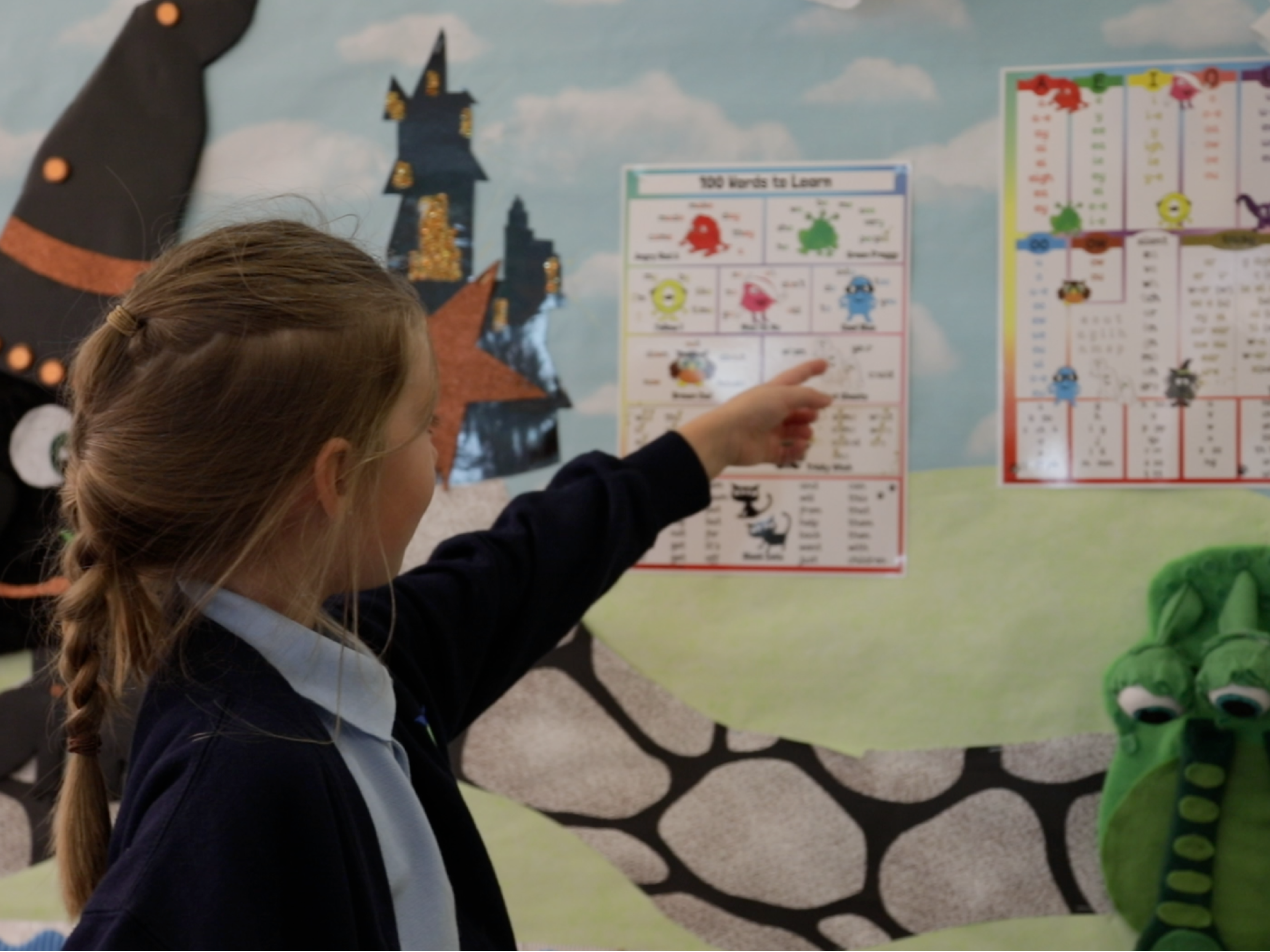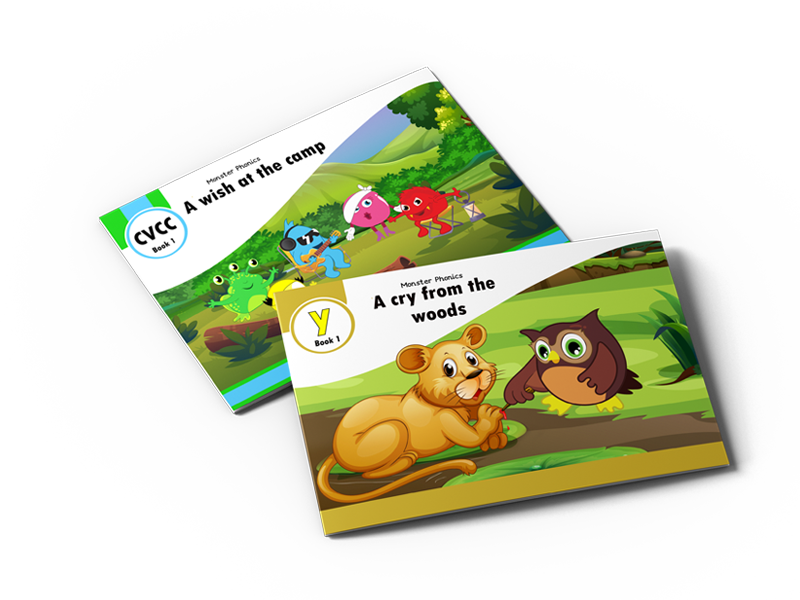DfE Systematic Synthetic Phonics Validation
Monster Phonics is a DfE validated systematic synthetic phonics programme.
Monster Phonics is child-centred and improves results. Children make progress because the approach is meaningful, interactive, and easy to understand, creating high engagement. The systematic colour-coding of graphemes linked to phoneme monsters makes phonics easier to understand. Children also love the monsters, and this brings phonics to life. Our activities are multisensory requiring reading, writing, singing and actions. Typically, schools that fully embed Monster Phonics increase phonics screening scores by 15% points in the first year. Studies also show a 23-month improvement in reading age over a 5-month period. These gains can be attributed to the child-centred systematic phonics teaching that underpins Monster Phonics.
What does Monster Phonics provide?
● Systematic synthetic phonics programme with easy-to-follow lessons plans, resources and assessment to teach Reception, Year 1 and Year 2
● Decodable reading scheme aligned to the teaching programme
● Training programme consisting of 26 online modules over 3 levels and course assessments. Regular meetings are scheduled throughout the first year with an assigned experienced trainer.
● Intervention
● Handwriting
● Parent logins and phonics webinars
● Masses of extra multi-sensory resources to help engagement
To start your subscription or to contact us for more information please contact us on [email protected].
The Department for Education’s phonics validation process ensures that schools are able to purchase comprehensive programmes with effective teaching to enable children to achieve and surpass expectations at the end of KS1.
So what is Systematic Synthetic Phonics?
Phonics is all about how the alphabetic system works, and how to apply it in reading and spelling. A programme should promote the use of phonics as the route to reading unknown words before any other comprehension strategies are applied.
Research shows that children learn to read best with a systematic synthetic approach to phonics with high quality teaching. Synthetic phonics teaches children how to blend or synthesise words using the smallest units of sound (phoneme). First, they are taught to connect the sound with the written representation (graphemes) which may be one letter or a group of letters (for example, igh). Then they are then taught to read by blending these sounds together. Spelling (also known as segmentation) is the reverse process.
Systematic means that the teaching progression is logical, starting with single letters sounds to enable children to read and spell simple words, leading to consonant digraphs and vowel digraphs ( 2 and 3 letter units) and longer words. Common exception words are also taught in a progression that fits within the phonics teaching programme.

What are the Criteria for Validated Programmes?
Validation will ensure that a programme is complete and provides all the resources necessary to teach children in Reception and KS1, up to or beyond the standards expected by the national curriculum. It should also provide sufficient support for children to become fluent readers.
The programme should:
- constitute a complete SSP programme providing fidelity to its teaching framework for the duration of the programme
- present systematic, synthetic phonic work as the prime approach to decoding print
- enable children to start learning phonic knowledge and skills early in reception, and provide a structured route for most children to meet or exceed the expected standard in the year one (Y1) Phonics Screening Check and all national curriculum expectations for word reading through decoding by the end of key stage 1
- be designed for daily teaching sessions and teach the main grapheme-phoneme correspondences of English (the alphabetic principle) in a clearly defined, incremental sequence
- begin by introducing a defined group of grapheme-phoneme correspondences that enable children to read and spell many words early on
- progress from simple to more complex phonic knowledge and skills, cumulatively covering all the major grapheme-phoneme correspondences in English
- teach children to read printed words by identifying and blending (synthesising) individual phonemes, from left to right all through the word
- teach children to apply the skill of segmenting spoken words into their constituent phonemes for spelling and that this is the reverse of blending phonemes to read words
- provide opportunity for children to practise and apply known phoneme-grapheme correspondences for spelling through dictation of sounds, words and sentences
- ensure that children are taught to decode and spell common exception words (sometimes called ‘tricky’ words), appropriate to their level of progress in the programme
- provide resources that support the teaching of lower-case and capital letters correctly, with clear start and finish points.
- The programme should move children on by teaching them to write words made up of learned GPCs, followed by simple sentences composed from such words as well as any common exception words (‘tricky words’) learned
- be built around direct teaching sessions, with extensive teacher-child interaction and involve a multi-sensory approach. The programme should include guidance on how direct teaching sessions can be adapted for online delivery (live or recorded)
- provide resources to enable teachers to deliver the programme effectively including sufficient decodable reading material to ensure that, as children move through the early stages of acquiring phonic knowledge and skills, they can practise by reading texts closely matched to their level of phonic attainment, that do not require them to use alternative strategies to read unknown words
- include guidance and resources to ensure children practise and apply the core phonics they have been taught
enable children’s progress to be assessed and highlight the ways in which the programme meets the needs of those who are at risk of falling behind, including the lowest attaining 20% of children - provide full guidance for teachers to support the effective delivery of the programme and appropriate, programme-specific training either directly, through appointed agents or remotely; with assurances that there is sufficient capacity to do so and that those delivering this training will have appropriately high levels of expertise and relevant experience.
What does the DfE say about Letters and Sounds?
“The 2007 Letters and Sounds handbook, published under the previous government, has never been a full SSP programme. For a number of years, effective teaching using Letters and Sounds has relied on schools themselves building a programme around the handbook. We recognise, however, that for many schools, especially those who want or need to improve their practice, 2007 Letters and Sounds is not fit for purpose and does not provide the support, guidance, resources or training needed.”
When Letters and Sounds was first published in 2007, it was the first time that detailed information was provided on how to teach SSPs. However, it can seem overwhelming and does not provide lesson plans and activities, placing a lot of demand on teaches to spend time on resource creation. It does not fit neatly with the KS1 Spelling Curriculum. Therefore it cannot ensure full coverage or provide all that is necessary to facilitate the teaching of quality phonics.

What should schools do next?
The final list of validated phonics schemes will be available by the end of February 2021. Schools do not have to use a validated programme, however by doing so, they can feel confident that the teaching content and methodology is in place to help children to meet and surpass the expected standards at the end of KS1, helping teachers to focus on teaching and children.
Is Monster Phonics validated?
Yes, Monster Phonics is validated by the DfE.
Our phonics scheme is available to use on a free trial. Fancy a look? Take a free trial today.
Take a free 7 day trial
Child-Centred and Delivers Results
The Monster Phonics Programme is an SSP that comprehensively delivers all 16 criteria. Our speciality and what makes Monster Phonics stand out is the engagement and love of learning that is felt in every Monster Phonics classroom. Easy to teach lessons are multisensory and enable every child to make progress. Monster Phonics is having a positive impact on learning in school across the UK. Monster Phonics Days, with input from across the school community, case studies and results show how children are engaged. Never before has phonics been embraced so much. The matching decodable books are also loved by children, teachers and parents tell the same story.
I’m the founder of monster phonics. As a teacher, my passion has been driven by the feeling that all children can succeed. The SSP validation process enables schools to feel confident that the phonics programme they use, the training, books and resources are aligned, comprehensive and importantly support teachers in this goal.







